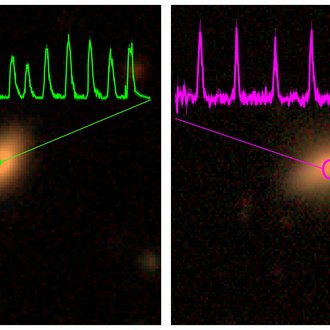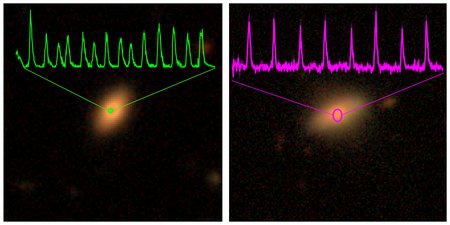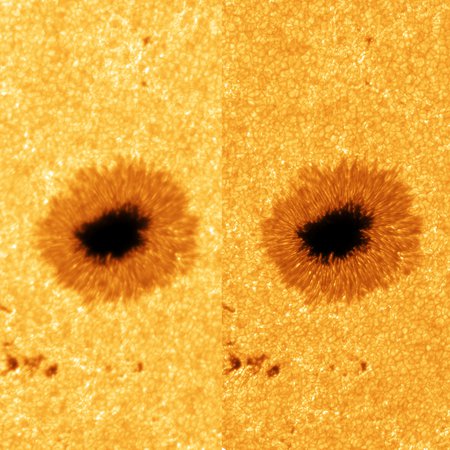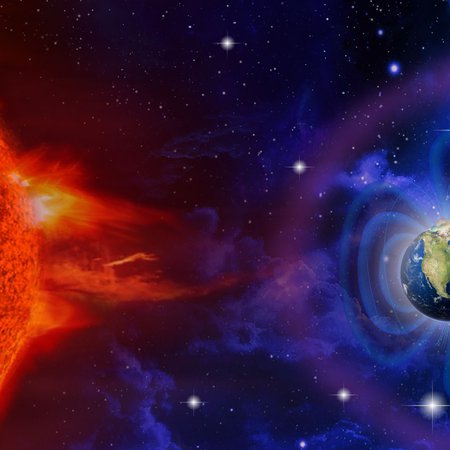eROSITA detects regular X-ray flashes from the vicinity of black holes

Left: Optical image of the first galaxy found with quasi-periodic eruptions in the eROSITA all-sky data, the NICER X-ray light-curve is overlayed in green. The galaxy was identified as 2MASS 02314715-1020112 at a redshift of z~0.05. About 18.5 hours pass between the peaks of the X-ray outbursts.
Right: Optical image of the second galaxy found with quasi-periodic eruptions in the eROSITA all-sky data, the XMM-Newton X-ray light-curve is overlayed in magenta. The galaxy was identified as 2MASX J02344872-4419325 at a redshift of z~0.02. This source shows much narrower and more frequent eruptions, approximately every 2.4 hours.
The all-sky survey with the X-ray telescope eROSITA identified strong, regularly recurring bursts of brightness in two previously completely unremarkable galaxies. Apparently, there are supermassive black holes at the centres of the observed galaxies, which a stellar object comes dangerously close to every few hours, as a study now published in Nature suspects.
Regularly every few hours, the nuclei of these galaxies light up in X-ray light, reaching a luminosity comparable to that of an entire galaxy. The cause of this pulsating behaviour is unclear. It may be due to a stellar object orbiting the central black hole in the galaxies.
Quasars or “active galactic nuclei” (AGN) are often called the lighthouses of the distant universe. At their centre, a massive black hole swallows up large amounts of material, shining up to a thousand times brighter than an entire galaxy like our Milky Way. However, unlike a lighthouse, AGN shine continuously. The two new active nuclei found with eROSITA behave quite differently.
“In the eROSITA all-sky survey, we have now found two previously quiescent galaxies with huge, almost periodic sharp pulses in their X-ray emission,” says Riccardo Arcodia, PhD student at the Max Planck Institute for Extraterrestrial Physics (MPE) and first author of the study. These kinds of objects are fairly new: only two such sources were known before. Both were found either serendipitously or in archival data in the past couple of years. “As this new type of erupting sources seems to be peculiar in X-rays, we decided to use eROSITA as a blind survey and immediately found two more,” he adds.
The eROSITA telescope currently scans the entire sky in X-rays and the continuous data stream is well suited to find transient events such as these eruptions. Both new sources discovered by eROSITA showed high-amplitude X-ray variability within just a few hours, which was confirmed by follow-up observations with the XMM-Newton and NICER X-ray telescopes. Contrary to the two known similar objects, the new sources found by eROSITA were not previously active galactic nuclei. Georg Lamer, project scientist at the Leibniz Institute for Astrophysics Potsdam (AIP), provided the software that enables the identification of new X-ray sources: “This made it possible to optimally determine the position of the source in the sky.”
“These were normal, average low-mass galaxies with inactive black holes,” explains Andrea Merloni at MPE, principal investigator of eROSITA. “Without these sudden, repeating X-ray eruptions we would have ignored them.” Axel Schwope, PI at the AIP, adds: “Using the optical spectrum from observations with the South African Large Telescope, we were able to show the 'normality' of the galaxies.” The scientists now have the chance to explore the vicinity of the smallest supermassive black holes. These have 100 000 to 10 million times the mass of our Sun.
Quasi-periodic emission such as the one discovered by eROSITA is typically associated with binary systems. If these eruptions are indeed triggered by the presence of an orbiting object, its mass has to be much smaller than the black hole’s – of the order of a star or even a white dwarf, which might be partially disrupted by the huge tidal forces close to the black hole at each passage.
“We still do not know what causes these X-ray eruptions,” admits Arcodia. “But we know that the black hole’s neighbourhood was quiet until recently, so a pre-existing accretion disk as the one present in active galaxies is not required to trigger these phenomena.” Future X-ray observations will help to constrain or rule out the “orbiting object scenario” and to monitor possible changes in the orbital period. These kinds of objects could also be observable with gravitational waves signals, opening up new possibilities in multi-messenger astrophysics.
eROSITA (extended Roentgen Survey with an Imaging Telescope Array) is an X-ray telescope built by a German consortium under the leadership of the MPE. The AIP contributes software for data evaluation, with a focus on determining the satellite's position and detecting the X-ray sources in the sky. The AIP also provided flight hardware for the camera filter wheels and the whole mechanical ground segment equipment for integration and tests of the X-ray telescope array.
Members of the AIP are also participating in the eROSITA scientific working groups. Optical identification of new X-ray sources is of major relevance: The eROSITA cluster and AGN surveys were selected as design reference surveys for the future 4MOST facility, a 4-meter multi-object spectroscopic telescope for the European Southern Observatory ESO, currently under construction lead by the AIP.
Further information
Original publication
Arcodia, R., Merloni, A., Nandra, K. et al. X-ray quasi-periodic eruptions from two previously quiescent galaxies. Nature 592, 704–707 (2021).
DOI: https://doi.org/10.1038/s41586-021-03394-6
MPE press release
Images
Left: Optical image of the first galaxy found with quasi-periodic eruptions in the eROSITA all-sky data, the NICER X-ray light-curve is overlayed in green. The galaxy was identified as 2MASS 02314715-1020112 at a redshift of z~0.05. About 18.5 hours pass between the peaks of the X-ray outbursts.
Right: Optical image of the second galaxy found with quasi-periodic eruptions in the eROSITA all-sky data, the XMM-Newton X-ray light-curve is overlayed in magenta. The galaxy was identified as 2MASX J02344872-4419325 at a redshift of z~0.02. This source shows much narrower and more frequent eruptions, approximately every 2.4 hours.
Big screen size [1000 x 501, 80 KB]
Original size [3732 x 1871, 620 KB]



